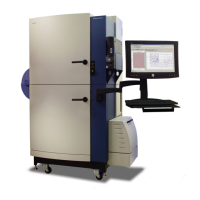Running an Experiment
166 0112-0109 H
3. Perform a Protocol Signal Test to evaluate the basal
fluorescence signal. The desirable fluorescence signal for
intracellular calcium assays is 200–1,200 fluorescence counts
for EMCCD camera and 500–5000 for ICCD camera.
When running a membrane potential assay, the basal
fluorescence counts should be between 1,500–2,500 counts for
standard, EMCCD camera or 10,000–15,000 for aequorin ICCD
camera to allow for a decrease or increase in the fluorescence
signal.
4. If the basal fluorescence signal is substantially out of these
ranges, the excitation intensity, exposure time and gain or gate
can be adjusted. Use the suggestions below to adjust the basal
fluorescence.
Basal fluorescence too low:
• Increase the Excitation Intensity if the basal fluorescence
signal is too low. During the assay, the Excitation Intensity
should range between 20% and 100%.
• Increase the Exposure Time. If you increase the Exposure
Time, the read interval will have to be increased to a minimum
of exposure time + 0.1 s (it takes 0.1 s to integrate the data).
• Increase the Camera Gain (EMCCD camera). The gain can vary
between 1 (extremely bright fluorescence) to 240
(luminescence).
• Increase the Gate Open (ICCD camera). The gate can vary
between 0.06% (extremely bright fluorescence) and 35% (very
dim fluorescence).
Camera Type
Calcium Assay
Membrane Potential
Assay
EMCCD ICCD EMCCD ICCD
Excitation wavelength
(nm)
470–495 470–495 510–545 510–545
Emission Wavelength
(nm)
515–575 515–575 565–625 565–625
Excitation Intensity
(%)
50 50 50 50
Exposure Time (s) 0.4 0.533 0.4 0.533
Camera Gain 130 2000 50 2000
Gate Open — 6% — 6%

